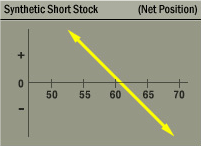Synthetic Short Stock
This strategy is essentially a short futures position on the underlying stock.
Description
The strategy combines two option positions: short a call option and long a put option with the same strike and expiration. The net result simulates a comparable short stock position's risk and reward. The principal differences are the time limitation imposed by the term of the options, the absence of the large initial cash inflow that a short sale would produce, but also the absence of the practical difficulties and obligations associated with short sales.
If assigned, the investor who doesn't take further steps to cover, ends up with an actual short stock position.
Outlook
Looking for a decline in the stock's price during the term of the options.
Since the strategy's term is limited, the longer-term outlook for the stock isn't as critical as for, say, an outright short stock position.

EXAMPLE
- Short 1 XYZ 60 call
- Long 1 XYZ 60 put
MAXIMUM GAIN
- Strike paid - net debit paid
MAXIMUM LOSS
- Unlimited
However, the difficulty of pinpointing the exact timing and sequence of a downturn, just before an upturn, suggests it is not an optimal strategy for a long-term bullish investor.
Summary
This strategy is essentially a short futures position on the underlying stock. The long put and the short call combined simulate a short stock position. The net result entails the same risk/reward profile, though only for the term of the options: limited but large potential for appreciation if the stock declines, and unlimited risk should the underlying stock rise in value.
Motivation
If used by itself, the strategy establishes a close approximation of a short stock position without the investor's having to actually sell stock short.
This spread is also used quite often as a hedge for a long stock position. Read more about that application under collar.
Variations
If the strike prices of the two options are the same, this strategy is a synthetic short stock. If the calls have a higher strike, it is sometimes known as a collar. The term is confusing, because it applies to up to three strategies. Depending on which option is long and which is short, collars can mimic either a long stock or a short stock position; the term itself applies to both. And because the synthetic short stock version is used so commonly as a hedge on a stock position, the three-part strategy entitled 'protective collar' is also known simply as collar.
Max Loss
The maximum loss is unlimited. The worst that can happen is for the stock to rise to infinity. In that case, the investor would be assigned on the short call and have to sell the stock at the strike price, resulting in an infinitely large loss. The loss would be higher (lower) by the amount of the debit (credit). In this worst case scenario, the put would of course simultaneously expire worthless.
Max Gain
The maximum gain is substantial but limited. The best that can happen is for the stock to become worthless, in which case the investor could buy stock in the market for zero and sell it at the strike by exercising the put. The gain would be even higher (lower) by the amount of the credit (debit) when the strategy was implemented.
Profit/Loss
As with a short stock position, the potential profit is substantial, and the potential losses are unlimited. An investor can do the research on the underlying and monitor the developments, but there is no guarantee of being able to get out of the short call position before the stock (or the call) becomes unaffordable.
Breakeven
This strategy breaks even if, at expiration, the stock is above (below) the strike price by the amount of the credit (debit) that the investor received (paid) when the strategy was implemented.
Breakeven = strike + net credit
(Breakeven = strike - net debit)
Volatility
Volatility is usually not a major consideration, all other things being equal. Since the strategy involves being both long and short an option with the same strike and expiration, the effects of volatility shifts will roughly offset each other.
Time Decay
Since the strategy involves being both long and short an option with the same strike and term, the effects of time decay will roughly offset each other.
Assignment Risk
Early assignment, while possible at any time, generally occurs only just before the stock goes ex-dividend for calls.
And be aware, a situation where a stock is involved in a restructuring or capitalization event, such as a merger, takeover, spin-off or special dividend, could completely upset typical expectations regarding early exercise of options on the stock.
Expiration Risk
The investor cannot know for sure whether or not assignment in fact occurred until the Monday after expiration.
Comments
This strategy is usually used to provide a nearly perfect hedge against a long position in the underlying stock. See the collar strategy discussion for details.
Related Position
Comparable Position: Short Stock
Opposite Position: Synthetic Long Stock

